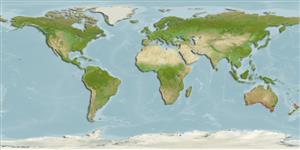Environment: milieu / climate zone / depth range / distribution range
Ecología
marino; rango de profundidad 1 - 15 m (Ref. 75154). Subtropical; 28°S - 45°S
Eastern Indian Ocean: southern Australia, from Houtman Abrolhos, Western Australia to Angourie Point, northern New South Wales (probably southern Queensland).
Tamaño / Peso / Age
Maturity: Lm ? range ? - ? cm
Max length : 35.0 cm SL macho / no sexado; (Ref. 6185)
Occurs near the surface in high energy surf zones along rocky shores, these areas are often dominated by brown macroalgae.
Life cycle and mating behavior
Maturities | Reproducción | Spawnings | Egg(s) | Fecundities | Larva
Gomon, M.F. and J.R. Paxton, 1985. A revision of the Odacidae, a temperate Australian-New Zealand labroid fish family. Indo-Pac. Fish. (8):57 p. (Ref. 6185)
IUCN Red List Status (Ref. 130435)
Threat to humans
Harmless
Human uses
Pesquerías: sin interés; Acuario: Comercial
Herramientas
Special reports
Download XML
Fuentes de Internet
Estimates based on models
Preferred temperature (Ref.
123201): 14.7 - 22, mean 17.6 °C (based on 317 cells).
Phylogenetic diversity index (Ref.
82804): PD
50 = 1.0002 [Uniqueness, from 0.5 = low to 2.0 = high].
Bayesian length-weight: a=0.00692 (0.00265 - 0.01809), b=3.08 (2.86 - 3.30), in cm total length, based on LWR estimates for this (Sub)family-body shape (Ref.
93245).
Nivel trófico (Ref.
69278): 2.7 ±0.2 se; based on size and trophs of closest relatives
Resiliencia (Ref.
120179): Alto, población duplicada en un tiempo mínimo inferior a 15 meses (Preliminary K or Fecundity.).
Fishing Vulnerability (Ref.
59153): Low to moderate vulnerability (33 of 100).
Nutrients (Ref.
124155): Calcium = 111 [63, 206] mg/100g; Iron = 1.47 [0.88, 2.42] mg/100g; Protein = 18.9 [16.9, 20.8] %; Omega3 = 0.299 [0.181, 0.524] g/100g; Selenium = 15.3 [8.2, 30.3] μg/100g; VitaminA = 12.3 [3.9, 37.1] μg/100g; Zinc = 1.15 [0.82, 1.62] mg/100g (wet weight);
